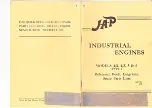
NOTICE
Turbocharger bearing failures can cause large quanti-
ties of oil to enter the air intake and exhaust systems.
Loss of engine lubricant can result in serious engine
damage.
Minor leakage of oil into a turbocharger under ex-
tended low idle operation should not cause problems
as long as a turbocharger bearing failure has not
occured.
When a turbocharger bearing failure is accompanied
by a significant engine performance loss (exhaust
smoke or engine rpm up at no load), do not continue
engine operation until the turbocharger is renewed.
A visual inspection of the turbocharger can minimize
unscheduled downtime. A visual inspection of the
turbocharger can also reduce the chance for potential
damage to other engine parts.
Removal and Installation
For options regarding the removal, installation, and
replacement, consult your Carerpillar dealer. Refer to
the Disassembly and Assembly, “Turbocharger -
Remove and Turbocharger - Install” and Systems
Operation, Testing and Adjusting, “Turbocharger -
Inspect” for further information.
Inspecting
NOTICE
The compressor housing for the turbocharger must
not be removed from the turbocharger for inspection
or removed for the cleaning of the compressor.
1.
Remove the pipe from the turbocharger exhaust
outlet and remove the air intake pipe to the
turbocharger. Visually inspect the piping for the
presence of oil. Clean the interior of the pipes in
order to prevent dirt from entering during
reassembly.
2.
Check for obvious heat discoloration of the
turbocharger. Check for any loose bolts or any
missing bolts. Check for damage to the oil supply
line and the oil drain line. Check for cracks in the
housing of the turbocharger. Ensure that the
compressor wheel can rotate freely.
3.
Check for the presence of oil. If oil is leaking from
the back side of the compressor wheel, there is a
possibility of a failed turbocharger oil seal.
The presence of oil may be the result of extended
engine operation at low idle. The presence of oil
may also be the result of a restriction of the line for
the intake air (clogged air filters), which causes the
turbocharger to slobber.
4.
Inspect the bore of the housing of the turbine outlet
for corrosion.
5.
Fasten the air intake pipe and the exhaust outlet
pipe to the turbocharger housing. Ensure that all
clamps are installed correctly and that all clamps
are tightened securely.
i02678854
Walk-Around Inspection
Inspect the Engine for Leaks and
for Loose Connections
A walk-around inspection should only take a few
minutes. When the time is taken to perform these
checks, costly repairs and accidents can be avoided.
For maximum engine service life, make a thorough
inspection of the engine compartment before starting
the engine. Look for items such as oil leaks or coolant
leaks, loose bolts, worn belts, loose connections and
trash buildup. Make repairs, as needed:
• The guards must be in the correct place. Repair
damaged guards or replace missing guards.
• Wipe all caps and plugs before the engine is
serviced in order to reduce the chance of system
contamination.
NOTICE
For any type of leak (coolant, lube, or fuel) clean up
the fluid. If leaking is observed, find the source and
correct the leak. If leaking is suspected, check the flu-
id levels more often than recommended until the leak
is found or fixed, or until the suspicion of a leak is
proved to be unwarranted.
NOTICE
Accumulated grease and/or oil on an engine is a fire
hazard. Remove the accumulated grease and oil. Re-
fer to this Operation and Maintenance Manual, “En-
gine - Clean” for more information.
• Ensure that the cooling system hoses are correctly
clamped and that the cooling system hoses are
tight. Check for leaks. Check the condition of all
pipes.
• Inspect the water pump for coolant leaks.
Note:
The water pump seal is lubricated by the
coolant in the cooling system. It is normal for a small
amount of leakage to occur as the engine cools down
and the parts contract.
SEBU8731
95
Maintenance Recommendations
Walk-Around Inspection










































